.
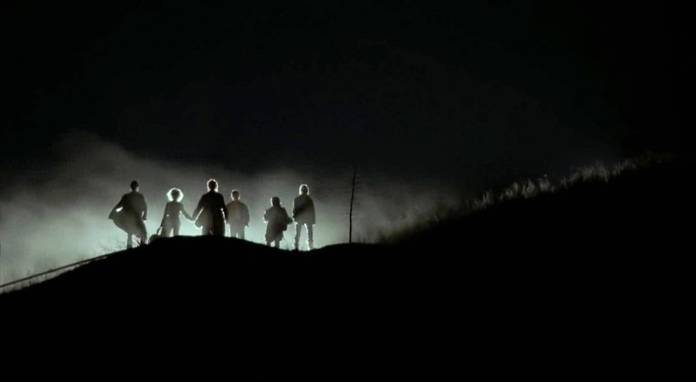
Director: Kathryn Bigelow
Screenwriters: Kathryn Bigelow, Eric Red
By Roderick Heath
Kathryn Bigelow’s been saddled with one of those milestone Oscar wins that carries the whiff of cultural formaldehyde, but I find her victory inspiring and amusing in the same way Peter Jackson’s was: the ascension to mainstream laurels of a directorial talent rooted in fare beyond the pale. Indeed, the impact of The Hurt Locker was imbued not by any deep, inherent dramatic qualities in its fairly basic and dramatically familiar, if thankfully terse screenplay, but by Bigelow’s spare, yet intense vision, which first truly gained attention with her mighty reinvention of the vampire movie Near Dark. Truth be told, Near Dark is a far more nuanced, provocative, gripping, multileveled work than The Hurt Locker, but because it’s a horror film, nobody paid it that kind of attention. And yet each time I revisit Near Dark, its innate confidence and supple intelligence become more defined. I’m now convinced it’s one of the best American films of the ’80s.

Near Dark was also one of a small but well-remembered barrage of vampire movies in the mid ‘80s, including The Hunger (1983), Fright Night (1985), Vamp (1986), Once Bitten (1985), The Lost Boys (1987), and A Return to Salem’s Lot (1987), that subjected the classic mythology to their own modish, modernising bent. Near Dark has had possibly the deepest impact on subsequent works, including Joss Whedon’s popular Buffy the Vampire Slayer TV series and Stephanie Meyer’s Twilight franchise, both of which make use of Near Dark’s ideas for portraying a peripatetic, clannish demimonde of bloodsuckers. And yet it also sustains a mood in common with other films of its era, like John McTiernan’s Nomads and David Lynch’s Blue Velvet (both 1986), that peered beneath the prim surfaces of contemporary America and suggested parallels for both forgotten underclasses and latent animalistic drives and chaos in emissaries of darkness. Likewise, Bigelow’s stark, savage, eerie evocation of the West fuses disparate versions of American culture into an original and arresting whole.

A running theme of Bigelow’s work is one of an intrusive outsider within a group that has developed a family dynamic, a dynamic as much defined by fractures as by fellowship. In Near Dark, it’s Caleb Colton (Adrian Pasdar), a coltish cowboy-wannabe still trying out his act when he and some of his young friends spy pale, young, ice-cream-licking waif Mae (Jenny Wright). Caleb approaches her, and she seems, in her alternately distracted and eager fashion, to dig him in return. After a night of toey, curious flirtation, Jenny becomes panicked about making it home before sunrise, and when Caleb stops his truck and refuses to take her further without a kiss, she agrees, but bites him on the neck and runs away. Caleb, quickly becoming ill, tries to make it home as the sun seems to burn him, and is snatched up by a speeding Winnebago before his veterinarian father Loy (Tim Thomerson) and younger sister Sarah (Marcie Leeds) can come to his aid.

Caleb’s been snared by members of the clan of vampires Jenny has been a part of for five years: Jesse Hooker (Lance Henriksen), the leathery, hardened, pragmatic patriarch, mated to Diamondback (Jenette Goldstein), a feral-freaky former victim of Jesse’s who serves as mother figure to Mae; wild good ole boy Severen (Bill Paxton); and Homer (Joshua Miller), a vampirised child housing an embittered man’s psyche. The vampires usually kill their prey—in this case, Caleb—immediately, but Mae begs for his life and promises to see him properly inducted into their ways by teaching him how to kill and feed off humans. Caleb, at first uncomprehending and terrified, tries to return to his home by bus, but has to bail out when he is afflicted with dreadful sickness that is only cured by drinking blood out of a gash Mae makes in her arm. However, Caleb can’t countenance the necessary act of killing people to feed. Loy and Sarah, meanwhile, begin a relentless highway hunt for Caleb.
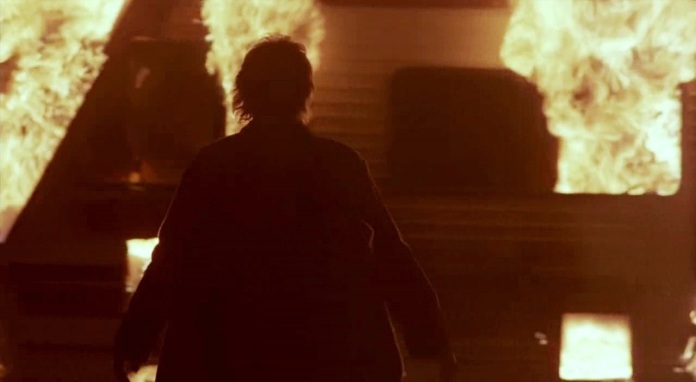
Other films had toyed with fusing aspects of classic Americana and Western mythology with the horror movie, with mostly embarrassing results (eg, Billy the Kid vs. Dracula, 1966), and with replacing the vampire genre’s traditional air of old-world decay and aristocratic glamour with other metaphorical impulses. Few succeeded like Bigelow did here. Her intelligence is proven throughout in the way she manages to conjure imagery that fuses multiple influences. In the same way that The Cramps’ recording of “Fever”—which plays throughout the film’s most infamous, iconic scene—takes a popular, playful song defined by slippery, deceptively subversive sensuality and invests it with an eerie, gothic vibe, so, too, does Bigelow rake over the sparse, desolate feel of the classic Western and do something new with it. The screenplay by Bigelow and Eric Red cunningly effects a psychic link between the Civil War, the Western tradition, the gangster movie, gothic horror, the counterculture, street culture, and the lost working class (“trailer trash”) left behind in Reaganite America, presenting them all as rooted in the landscape and the mood of alienation, otherness, and rebellion latent in the louder national identities.
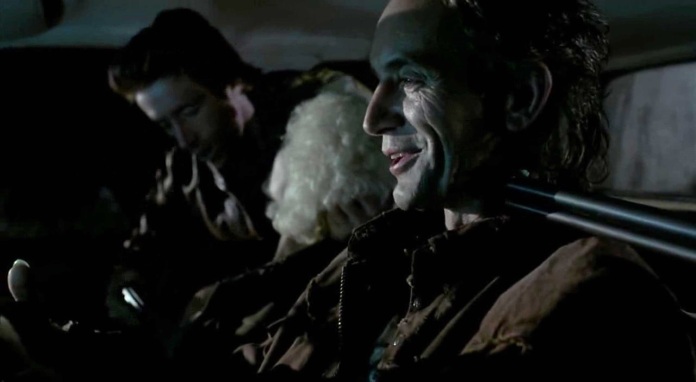
These wandering vampires, living out of cars and motels, feed off the easily missed in a vast nocturnal Midwest of scantly lit, depopulated streets, bleak motels, diners, honkytonks, and bus stops full of drifting flotsam. Carnivorous callousness contrasts ironically with the care that manifests between people, both in the human world and in their world. A ticket seller won’t help out an obviously ill young man, and Caleb’s assumed to be a junkie by a plainclothes cop (Troy Evans). And yet a security guard giving Caleb a few bucks to pay his fare, and Jesse and Diamondback, both resembling hippie wash-ups, adopt the social refuse they come across. Yet that pair also embodies something far more primal and dangerous. They reign over an amusingly sick facsimile of a nuclear family governed by their own perverse family values, wolfish in their darkness and lean hunger. Jesse himself is actually a Confederate veteran (“We lost!”), still embodying the bushwhacker creed. Bigelow plays games with the usual codes of that family structure, with the young boy the most grotesque of the lot and Caleb reduced to a mooching deadbeat getting his sustenance directly from Mae’s veins. The carefully cast Wright seems both delicate and doe-like in some scenes, and a strong, powerful antelope in others, relating to Caleb as if he is the damsel in distress—which he is initially.
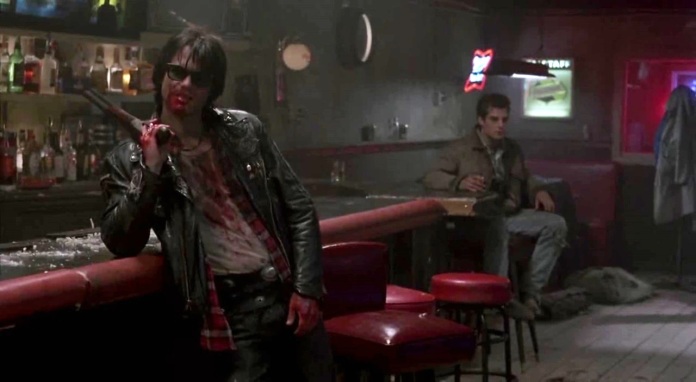
Near Dark’s crucial, classic scene depicts the clan invading an isolated bar (“Well I’ll be goddamned,” Severen declares: “Shit-kicker heaven!”), where Severen delights in terrifying, insulting, and slaughtering the patrons, defying and outdoing all the macho posturings of the clientele. Jesse cuts a waitress’s throat and drains her blood into a beer glass. Mae wipes blood coating her lips away as she marches up to a terrified young cowboy (James LeGros) and then asks him to dance, and Caleb gets a gutful from the shotgun-wielding barman (Thomas Wagner), which Severen avenges by slicing the barman’s throat with a few deft kicks of his cowboy spurs. The sequence’s woozy black humour, atmosphere of malefic menace and judicious flourishes of dazzling gore are spellbinding as the patrons, for all their air of seamy toughness, realise they’re contending with something completely unnatural. The vampires, however, fail in their nominal purpose, which is to impress Caleb with their strength and prerogative and create a clear ground for him to have his first meal of live blood. It’s a brilliant scene, all the more so for the fact that it succeeds in being both horrific, as opposed to merely gross-out, and compulsively entertaining, so charismatic is Paxton’s hammy, relished evil and the thrill of power and undercurrent of lethal misanthropy that unites the vampires. Caleb chases after the young man, who resembles himself, when he dashes out of the joint, but lets him go out of empathy for the terrified lad.
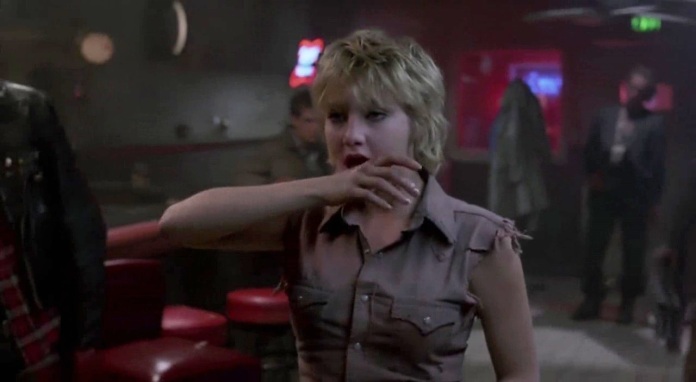
This proves a near-fatal mistake, however, as the incensed clan consider killing their unwanted charge. The young man leads the police to the hotel where the clan are shacked up, and the violent shoot-out that follows, with every bullet hole allowing in a deadly bolt of sunlight, sees Caleb save the day by fetching their van and crashing it though the room wall, giving them the chance to flee. This literally earns Caleb his spurs, as Severen gives him one of his. Layering the narrative are fascinating character and story flourishes that often tweak the familiar presentiments both of this type of narrative and the kinds of family and sexual dynamics it portrays. Loy’s protectiveness for Caleb and Sarah blurs the line between patriarchal and matriarchal care. Jesse and Diamondback’s recalling, like an old married couple, how they met (“And I just knew you were trouble,” Diamondback purrs), a relationship born in violence that has become uniquely loving. Mae and Caleb’s relationship is defined by alternations of dewy teenage love and amusing, unnerving fluctuations of power and need.
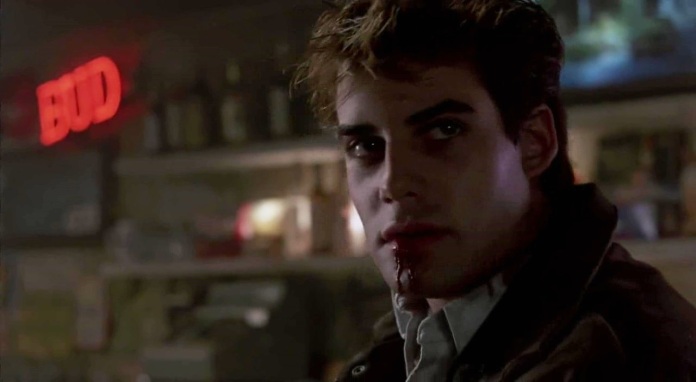
The image of Caleb drinking from Mae’s arm as lightning flashes and oil derricks pump and grind away behind them is one of the most memorable in the history of the horror film, blurring all divides between sex and sustenance, male and female, technical and supernatural, the modern and the primeval, a visual simile for the industrial, bodily, and emotional heart’s everlasting workings. The circular equation of blood equaling both family and life closes logically when Loy’s transfused blood proves to have the capacity to restore Caleb to humanity, a gift Caleb is then finally able to extend to Mae. Most uneasy and bizarre is Homer’s lot, as he insistently reminds his fellows: “Do you have any idea what it’s like to be a big man on the inside and have a small body on the outside?” Having vampirised Mae out of a desire for her that’s remained for him painfully unconsummated, Homer sets his sights on Sarah.
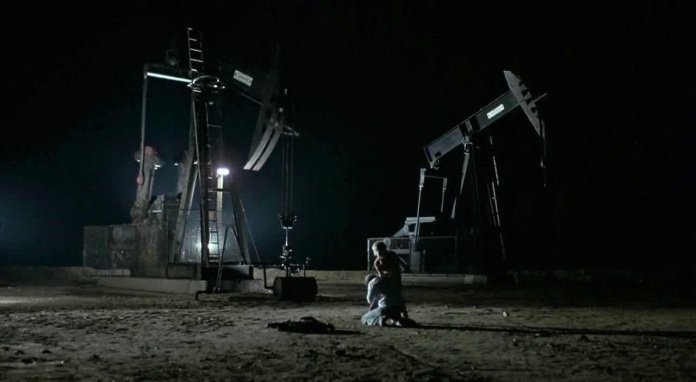
Homer, instantly besotted by Sarah’s forthright attitude, is somehow forlornly innocent and creepily redolent of a paedophile all at once, the most thoroughgoing example of how Bigelow blurs dichotomous concepts into each other. Even Mae’s ice-cream eating at the outset was only a prop (food is inedible for vampires) to draw in just such a victim as Caleb. Bigelow’s style, with her crisply photographed widescreen frames (courtesy of Adam Greenberg’s beautiful photography) and rhythmic editing, was and is definitely modern. And whilst in initial scenes, Pasdar’s and Wright’s performances feel touchy, even blowsy, nervous, and slightly unfocused, these acting traits are actually a Bigelow trademark—the offbeat affectations often expose the uneasy threat at the heart of her tales: Jeremy Renner’s The Hurt Locker performance is similar.
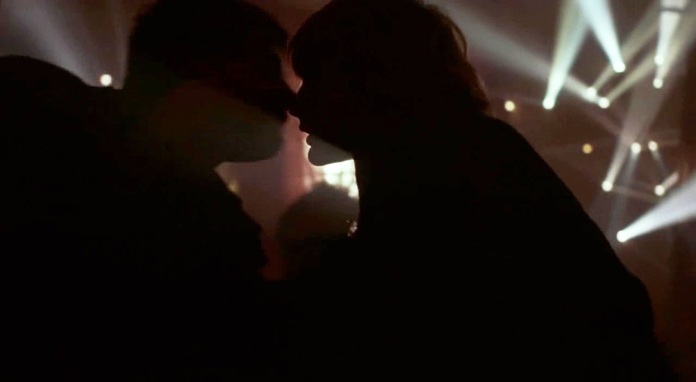
That Paxton, Henriksen, and Goldstein had all been in James Cameron’s Aliens the year before lends a touch of stock company camaraderie to the project, and they’re all ruthlessly convincing. The feel for the dizzying spaciousness of the prairies, and the inverted, claustrophobic night that swallows that flat and featureless land is moody and precise. The motel shoot-out, technically excellent action filmmaking that undoubtedly presages Bigelow’s later move entirely into that mode, evokes a very similar scene in Bonnie and Clyde (1967). But Bigelow’s love of Western iconography is most often in evidence, as Caleb’s growth into manhood sees him finally saddling up and riding to the rescue like a good cowboy to face down Severen in a High Midnight climax on a deserted street.

It’s only here, really, that Bigelow loses her total grip on the proceedings, as Severen’s demise via a jack-knifing, exploding truck apes, but doesn’t match, a similar scene in her then-husband’s The Terminator, and Caleb’s strutting confrontation with the vampires seems a bit unlikely considering he knows what they’re capable of doing to his once-again-human ass. The subsequent rush of Caleb, Mae, and Sarah to escape the remaining clan sees one of those amusingly quick-rising suns that often afflict vampire films. Nonetheless, the finale recovers to offer a blindingly bizarre, exciting, yet poignant consummation. Homer, chasing after Sarah in desperation, catches fire in the rising sun and burns away to a cinder, and Jesse and Diamondback roast alive in their station wagon as Jesse glowers in defeated ire whilst she beams at the glory of going out with her man. In such moments, Near Dark staked an irretrievable place in the hearts and minds of movie fans.

While I am not quite so sure I’ll annoint this as a placeholder on any ‘Greatest American Films of the 80’s” list, I really can’t say I blame you for doing so, as it is a very good film, that I readily agree with you when you say:
“Truth be told, Near Dark is a far more nuanced, provocative, gripping, multileveled work than The Hurt Locker, but because it’s a horror film, nobody paid it that kind of attention.”
True on every count here, methinks. When one achieves the kind of success and awards that were bestowed on Bigelow this past year, the creative work done before is often slighted.
Greenberg’s cinematography was really amazing here.
LikeLike
It’s better than Driving Miss Daisy.
LikeLike
It’s better than Driving Miss Daisy.
Hahahahahahahahahahahaha!!!!!!!!!!!!!!!
I thought that was an inside joke Rod!!!!!!!
LikeLike
Bless you Rod for giving time to this “lost” masterpiece!!!
I take pleasure in introducing people to this film as often as allowed. Remembering of course that until this movie we thought we knew what to expect from a “Vampire” movie. Not only were many conventional mainstays thrown out so was the word vampire, which was not mentioned once,. No winged flight or other signs of this genre rear their toothy heads. Instead we end up with what could have been really BIG if it weren’t for the bankruptcy of Delaurentis Entertainment which limited its debut to about two weeks. It still riles me to see the place of stature denied this milestone film supplanted by the standard mediocrity supplied in the release of The Lost Boys in the same time period. Well at least we do have a box set available courtesy of Anchor Bay. And a well thought out review by you my friend.
LikeLike
Something else I learned courtesy of the Anchor Bay notes: Bill Paxtons 80’s cult band Martini Ranch did a music vid directed by James Cameron for their song “Reach” a western spoof featuring Paxton as an outlaw hunted down by a posse of Amazon Cowbow Women led by Kathryn Bigelow with cameos by Lance Henriksen and Jenette Goldstein.
LikeLike
Sam: I could have picked just about any Best Picture winner of the ’80s to make that crack save Amadeus, The Last Emperor, and maybe Chariots of Fire, and I’d sooner watch Near Dark again than those too. The ’80s line-up of Oscar winners is pretty weak, particularly in the decade’s second half.
Shane: I recall thinking when I finally encountered Near Dark that it was both obviously seminal and influential, and yet also in a way represented a promise that has been largely unfulfilled by the genre. Given that De Laurentiis had spent most of the late ’70s and early ’80s driving the horror genre into the ground, it was tragic that their deserved demise took this more original and dynamic film down with it. There’s no way in hell The Lost Boys is better (Joel fucking Schumacher!), but I suppose it has a certain nostalgic cache as a quintessential ’80s youth flick. It’s possible at least now that Bigelow’s back in the spotlight some of her worthy but often ill-used earlier films will get more attention: I’ve always found it painful that before The Hurt Locker her most lauded film was the dumb-dumb Point Break. I’ve heard about the “Reach” video, but not seen it yet.
LikeLike
Yeah I’m seekin’ it as we speak.
LikeLike
“But Bigelow’s love of Western iconography is most often in evidence”
I’d be curious to know how much of this was Bigelow’s influence or screenwriter Eric Red. He also wrote THE HITCHER which also indulges in a love of Western iconography as well so that’s definitely a preoccupation of Red’s.
NEAR DARK is a fantastic vampire film that I don’t think has been equaled until perhaps Abel Ferrara’s THE ADDICTION, which pretty amazing in its own right.
As you point out, it’s fascinating to see how NEAR DARK has influenced other vampire stories, most notably BUFFY THE VAMPIRE SLAYER and TWILIGHT. In the latter’s case it doesn’t hold a candle to Bigelow’s film but I do like how Joss Whedon took some of the themes in NEAR DARK and ran with them, exploring them in greater detail on his show.
I really enjoyed this excellent review!
LikeLike
Reach video
LikeLike
I was a big fan of Whedon’s Buffy, so when Shane introduced me to this film, it was deja vu all over again, and I really dug it. Near Dark seems so expansive, and I think the road movie/Western aspect of the film is the reason. It’s quite a twist on a genre that is normally so claustrophobic.
LikeLike
Thanks for the vid link, Shane, I’ll take a look when my connection gets put back to proper speed…
JD: I hadn’t looked up Red’s credits, but instantly on reading your comment I saw the accord between Near Dark and The Hitcher. The spooky, deserted, vast neo-western feel is certainly common to both. I’m glad you and Marilyn immediately knew what I was thinking of when I pointed out the Buffy influence. As for The Addiction, that’s another film I had a chance to catch once and blew it…
A funny thing: I remembered why the film’s atmosphere felt so vivid to me. It recreates exactly the world of bus stations and nocturnal highways and lonely cities I travelled through when going to see Shane in Savannah and after I left him there…
LikeLike
He makes me feel so deserted though truth be told he had to leave me there…it’s where I was living at the time….
LikeLike
“Amadeus” weak?!? I think it’s a masterpiece.
LikeLike
I didn’t say that. I said ’80s Best Picture winners were generally weak but I make an exception for the three listed above all of which I like.
LikeLike